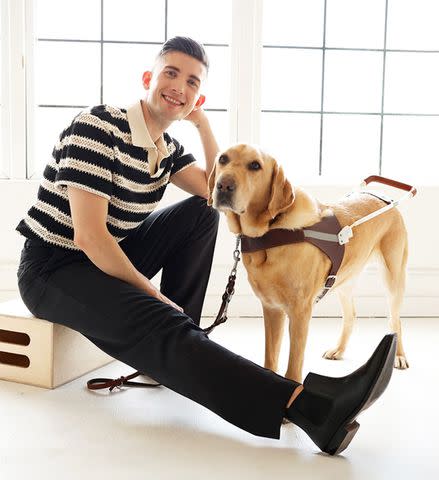TikToker Paul Shares the Reality of Living with Blindness — and Why Fake Service Dog Vests Are So Dangerous
The legally blind TikTok star from 'Matthew and Paul' talks about living with blindness, and how fake "service dog" vests bought online can hurt the disabled

Courtesy Matthew and Paul
Legally blind TikToker Paul with his service dog Mr. Maple.Paul — from the TikTok duo 'Matthew and Paul' — was just eight years old when he knew something was wrong with his vision
He went viral in April after sharing that he was denied access to a restaurant by a staffer who didn’t believe that his dog, Mr. Maple, was a guide dog — part of a disturbing trend being fueled by fake “support dog” vests purchased online
He's hoping to "educate everybody to understand that the spectrum of disabilities is far outside of what most people assume"
TikToker Paul — from the wildly popular duo Matthew and Paul — remembers the exact moment he knew something was wrong with his eyes.
“I was on a camping trip when I was a kid in eastern Washington,” he says, adding that he was around eight at the time. “Everybody was pointing out constellations in the sky and I looked up and I just couldn't see anything. And my brother was pointing out the Big Dipper and I was feeling the FOMO, so in my own frustration, pretended I could see.”
He tells PEOPLE that it wasn’t until he was 16, and trying to learn to drive, that “we knew something was definitely very wrong with my eyes.”
The diagnosis: retinitis pigmentosa which, according to the National Eye Institute, causes the “cells in the retina [to] break down slowly over time, causing vision loss.”

Courtesy Matthew and Paul
Legally blind TikToker Paul with his service dog Mr. Maple.Now the Seattle resident, along with his husband Matthew, share how Paul navigates life and his career as a graphic designer — all while while dealing with a degenerative eye disease — on their TikTok account.
This past April, Paul shared that he and his guide dog, Mr. Maple, were denied access to a local restaurant by a staffer who didn’t believe that Paul was really blind — or that Mr. Maple was really a legitimate guide dog, in spite of his harness indicating that he was.
The post immediately went viral, with 2.2 million likes and more than 13 million views.
But what happened to Paul is part of a growing trend, as Chris Diefenthaler, Executive Director for Assistance Dogs International, tells PEOPLE.
“Handlers who have trained assistance dogs are still continuing to be denied access,” she says, adding that along with restaurants, ride shares often “just kind of go right on by and don't stop.”
Never miss a story — sign up for PEOPLE's free daily newsletter to stay up-to-date on the best of what PEOPLE has to offer, from juicy celebrity news to compelling human interest stories.
Diefenthaler and Paul both tell PEOPLE that the reason service dogs are often looked at with a skeptical eye is because of a proliferation of fake "guide dog" vests, which can be easily purchased online.
In fact, Paul was originally denied access to the restaurant because the staffer had dealt with an unruly "service dog" the day before.
Related: YouTube Star MrBeast Helps 1,000 Blind People See Again by Paying for Their Cataract Surgeries
“It's not coming from a malicious place. People love their animals,” Paul says. “They want to take them everywhere, right? But now that I'm on the other side of it, I realize how it's impacting the lives of people who really need these dogs. Many of them are life-saving.”
He continued: “Maple saved my life. He has stopped me from cars breaking traffic laws downtown. He’s blocked me.”

Courtesy Matthew and Paul
Legally blind TikToker Paul with his service dog Mr. Maple.There are two types of service dogs, Diefenthaler tells PEOPLE.
“The term assistance dog is more the generic term that covers guide hearing and service dogs. And guide dogs are specific to the visually impaired or blind,” she says.
“Service dogs is a much broader category, and it really encompasses multiple types of disabilities, many of them invisible disabilities,” she says. For example, some dogs can alert their owner that they’re about to have a seizure.
“Diabetic service dogs detect low blood sugar," Diefenthaler says, and “could alert their individual that they're about to have or that they're having a low blood trigger — so they can take appropriate action.”
“All would be considered invisible disabilities,” she says.
During his restaurant encounter, Paul recalls how he was told, " 'You don't look blind.' ”
The PEOPLE Puzzler crossword is here! How quickly can you solve it? Play now!
“I tried to explain to him [that] I have a pinpoint of vision at the center of my eye,” says Paul. "And what we do online every day is educate people about the spectrum of blindness.”
Most people who are legally blind retain some sight, Verywell Health reports.
Paul hopes “that my platform and these instances and more videos like this can begin to chip away at those stereotypes and educate everybody to understand that the spectrum of disabilities is far outside of what most people assume they are.”
For more People news, make sure to sign up for our newsletter!
Read the original article on People.


